Exhibit - Daily Life
What did the people of the Tarim Basin eat?
Nomadic herders depended on sheep for meat and milk, while farmers in settlements relied on crops like wheat.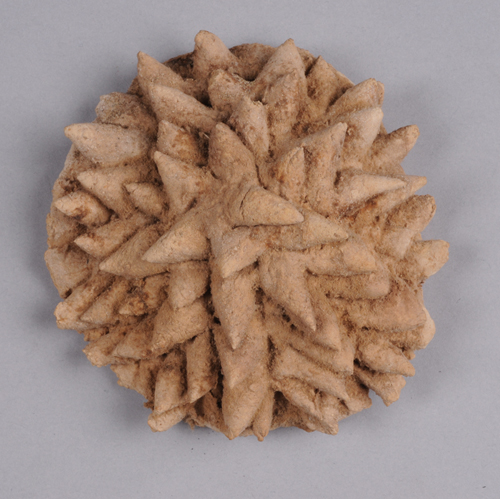
Chrysanthemum Shaped Dessert, 5th-3rd century BCE, Excavated from Tomb No. 73, Zaghunluq, Chärchän Xinjiang Uygur Autonomous Region Museum Collection.
Finding reliable food sources in the desert was key to survival. Nomadic herders relied on their flocks of sheep to provide milk, which could be preserved and carried as yogurt and cheese. Sheep could also provide a source of meat. The settled people of the Tarim Basin harvested wheat to make the different kinds of dough foods, as seen here. The food items on display appear as though they were made yesterday. In reality, all of the food here is at least 1,000 years old, with some pieces nearly 1,500 years old. The same desert conditions that kept these foods intact also preserved the human remains and textiles.
Sheep and wheat were first domesticated in the Near East over 11,000 years ago. Several thousand years later, they were brought to Eastern Central Asia, where they became key components for food in the Tarim Basin. |
What language did they speak?
To date, records of 28 different languages have been discovered in the Tarim Basin.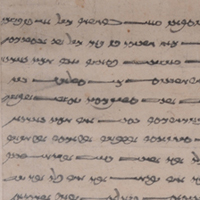
Sogdian Language Bill of Sale for Female Slave, AD 639, Excavated from Tomb No.135, Astana, Turfan, Xinjiang Uygur Autonomous Region Museum Collection
One reason scholars were able to decode the extinct Tocharian language was that it was written in Brahmi script, an alphabet that originated in India. |
What did their clothing look like?
The earliest inhabitants of the region had naturally colored formless woolen wraps. Later inhabitants created fitted clothing in different colors, styles, and patterns.
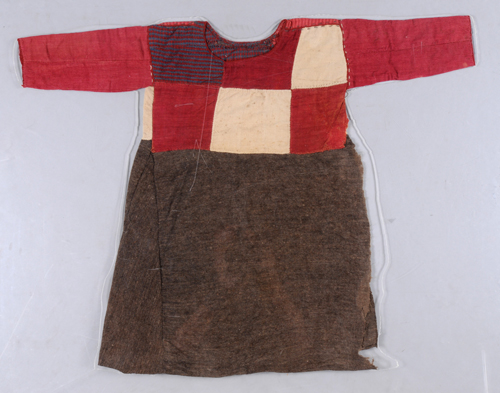
Pullover skirted dress, ca. 5th-3rd century BCE. Excavated from Tomb No. 55 of Cemetery No. 1, Zaghunluq, Charchan, Xinjiang Uygur Autonomous Region, China. © Xinjiang Uygur Autonomous Region Museum.
Some of the most breathtaking material excavated in the Xinjiang (shin-JEE-ahng) Province of China is the array of textiles, from wool felt to intricately woven silk brocades. Because organic materials can quickly deteriorate, the survival of so many ancient, yet well-preserved textiles is extraordinary. The sheep, which provided the people of the Tarim Basin with food, also supplied wool for weaving and felting clothing as well as for shelter materials. From simple felted pieces, to more intricate woven fabrics, wool was imperative for surviving the cold winters in Eastern Central Asia. Many silks and brocades were also found there. They show the advances in dyeing, weaving, and cloth-making, as well as evidence of trade along the Silk Road.
The manufacture of silk was originally a secret known only to the Chinese; however, with the travel and trade of the aptly named Silk Road, the techniques used for creating this delicate fabric spread as well. |
Did they make all of these objects?
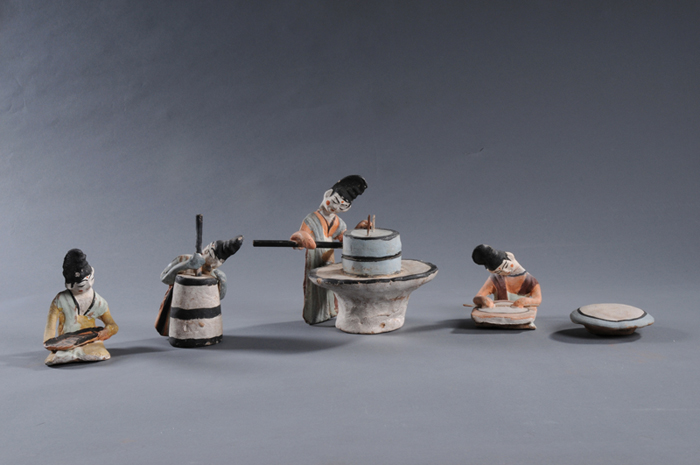
Group of Female Pottery Figures at Work, 7th-9th century, Excavated from Tomb No.201, Astana, Turfan, Xinjiang Uygur Autonomous Region Museum Collection
Many of the superbly crafted figurines and paintings that survive today represent the importance of theater and dance to Tang Dynasty culture. |
What did people in the Tarim Basin believe?
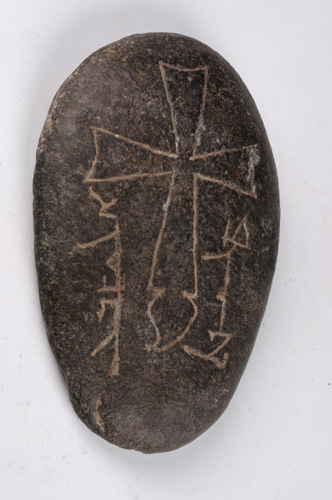
Stone Tablet with Nestorian Cross, 14th century, Excavated from Qorghas County, ancient Alimalik City Xinjiang Uygur Autonomous Region Museum Collection.
Little is known about the religions and beliefs of the regionís first inhabitants. However, with the increasing travel of the Silk Road, many religions spread and grew throughout the region. The spread of Buddhism, which originated in India, was made possible by the Silk Road. The town of Kucha (KOO-chuh) in the Tarim Basin became a major center for Buddhism and home to one of the premier translators of Buddhist texts. Religions such as Zoroastrianism (zor-oh-AHS-tree-an-ism) and Manicheism (man-eh-KEE-ism), both of Iranian origin, spread between the 3rd and 10th centuries CE. Additionally, there is evidence for followers of Judaism, Nestorian Christianity, and Islam throughout the region. While there is no evidence of a religion unique to the area, many faiths were practiced by the people of the Tarim Basin.
We do not know what religions the first inhabitants of the Tarim Basin practiced, but by the time of the Silk Road, many major religions were present in the area.
The last religion to significantly influence the Tarim Basin was Islam, which grew in popularity over 1,000 years ago, and remains the dominant religion in Xinjiang today. |















